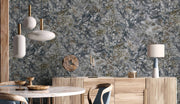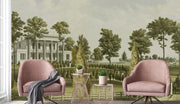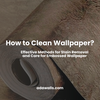How to Remove Wallpaper Safely | Adawall

Removing wallpaper might seem like a messy and time-consuming task, but with the right tools, techniques, and a little patience, it’s absolutely manageable. Whether you're preparing your wall for a fresh coat of paint or planning to apply a new design from Adawall's premium wallpaper collection, this guide will walk you through the best way to remove wallpaper without damaging your surfaces.
Why Proper Wallpaper Removal Matters
Improper wallpaper removal can lead to serious problems, such as:
-
Damaging the underlying wall
-
Leaving behind glue residue
-
Uneven surfaces that affect new wallpaper installation
-
Increased labor and renovation costs
At Adawall, we believe wallpaper removal should be as smooth and stress-free as installation. That’s why our wallpapers are made not only for aesthetic appeal but also for easier application and removal.
Types of Wallpaper and How to Remove Them
Different wallpaper types require different removal approaches. Let’s explore the most common types:
Peel and Stick Wallpaper
This type of wallpaper, often referred to as removable wallpaper or self-adhesive wallpaper, is one of the easiest to remove. Adawall’s peel-and-stick designs are crafted to ensure hassle-free application and clean removal.
How to remove it:
Start peeling from a corner and gently pull at a 45-degree angle. If resistance occurs, use a hairdryer to warm the adhesive slightly. This softens the glue and helps you avoid tearing.
Popular search terms:
how to remove peel and stick wallpaper, easy removable wallpaper
Traditional Wallpaper (Pasted)
This type is typically installed using wallpaper paste or glue. Removal takes more time and involves soaking the wallpaper to dissolve the adhesive.
How to remove it:
Use a wallpaper scoring tool to create small holes in the surface. Spray the area with hot water or a commercial wallpaper remover. Let it soak for 10–15 minutes, then gently scrape with a putty knife or wallpaper scraper.
Popular search terms:
how to remove old wallpaper, best wallpaper removal solution, wallpaper scraping tools
Vinyl-Coated Wallpaper
Vinyl wallpapers are moisture-resistant and more durable, but the top layer blocks water from reaching the adhesive underneath.
How to remove it:
First, score the surface using a perforation tool. Then apply your solution and allow it to soak. Scrape gently with the appropriate tool.
Recommended Tools for Wallpaper Removal
To remove wallpaper efficiently and safely, here are the tools professionals recommend:
-
Wallpaper scraper or putty knife
-
Wallpaper perforation (scoring) tool
-
Spray bottle or pump sprayer
-
Wallpaper removal solution or DIY vinegar mix
-
Sponge and bucket with warm water
-
Protective gloves and safety glasses
-
Steamer (for stubborn, layered wallpapers)
-
Drop cloths or plastic sheeting to protect floors
Step-by-Step Wallpaper Removal Process
Step 1: Prepare the Room
Move or cover furniture, turn off power in the working area, and cover electrical outlets and floors. Clean, dry, and unobstructed surfaces will make the process easier and safer.
Step 2: Test the Wallpaper Type
Try peeling off a corner. If it comes off easily and cleanly, it's peel-and-stick. If not, it's most likely traditional wallpaper or vinyl-coated, which will require soaking and scraping.
Step 3: Score the Wallpaper
If the wallpaper is not peel-and-stick, use a scoring tool to perforate the surface. This allows the removal solution to penetrate and dissolve the glue underneath.
Step 4: Apply the Wallpaper Remover
Spray the area with a commercial wallpaper remover or a DIY mix of warm water and white vinegar. Let it soak for at least 10–15 minutes before scraping.
Alternative solution:
A mix of one part vinegar and two parts warm water works well for most wallpaper adhesives.
Step 5: Scrape Gently
Use a wide putty knife or wallpaper scraper to lift the wallpaper from the wall. Be careful not to dig into the drywall or plaster. Work in sections and take your time.
Step 6: Remove Glue Residue
After all wallpaper is removed, clean the wall with warm soapy water or a vinegar solution to get rid of any leftover adhesive. Let the surface dry completely before painting or installing new wallpaper.
When to Use a Steamer
In cases where wallpaper is old, layered, or extremely stubborn, a steamer may be necessary. A wallpaper steamer uses hot water vapor to loosen the adhesive.
How to use it:
Hold the steamer plate against the wall for about 10 seconds, then scrape off the loosened wallpaper. Repeat as needed.
Popular search terms:
wallpaper steamer for removal, how to use wallpaper steamer
Use caution with steamers, especially on drywall, as too much moisture can cause damage.
What to Avoid During Wallpaper Removal
-
Do not rush the process.
-
Do not use excessive force with scraping tools.
-
Avoid soaking drywall for too long; it may weaken the surface.
-
Do not install new wallpaper over glue residue.
Why Choose Adawall Wallpapers for Easy Removal
At Adawall, we believe beautiful walls should come with peace of mind. That’s why our wallpapers are designed for both easy installation and clean removal. Whether you choose peel-and-stick or traditional styles, you can count on:
-
Removable adhesives that reduce wall damage
-
Safe, low-VOC materials for healthier indoor air
-
High-quality papers that resist tearing during removal
-
Clear application and removal instructions with every order
Planning to Redecorate?
Once your old wallpaper is removed, it’s time to create something new. Visit adawalls.com to explore our newest collections of luxury wallpaper in timeless patterns, modern designs, and child-friendly options.










